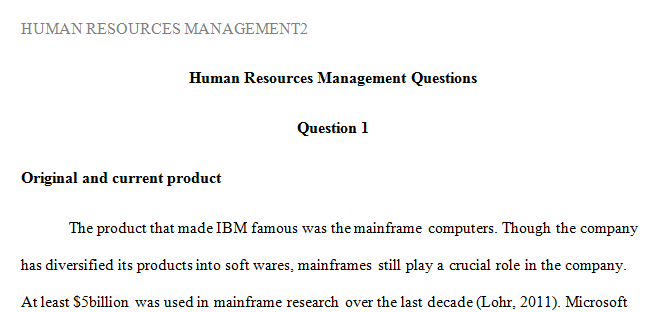The famous companies in this article have had the opportunity to grow and change over time.
QUESTION 1: Organizational growth and development – “Lessons in Longevity from IBM” https://www.nytimes.com/2011/06/19/technology/19unboxed.html (20 points)
The famous companies in this article have had the opportunity to grow and change over time. Re-read this article so that you can be reacquainted with its history. The author lines up the growth stages IBM went through as a business and then compares Microsoft, Google, and Apple. Compare IBM and these three companies to each other based upon:
• Original product (s) that made the company famous.
• Current product(s) that keep the company active in the marketplace.
• Culture: what stands out about each company’s internal environment?
• Future: whether each company will continue to be a major player in the technology sector and why.
• State the major lesson or truth that makes you admire or at least take each of these companies seriously!
• Of these four (4) companies, which one would you work for? Why?
QUESTION 2: Motivation is an essential element for all stakeholders in business. Use Pink’s viewpoint to analyze and answer the following situation. Watch his video, “The Amazing Truth About What Motivates Us” https://vimeo.com/15488784
Managers of entry-level employees understand that they are helping new graduate employees acclimate to the culture and the job itself. Many large companies that offer “leadership development programs” for high potential college graduates are hiring based on potential as much as a solid college degree (in English as well as business). Technical skills can be taught or reinforced. The gamble is that bright, motivated new college graduates will be very driven to learn their jobs and develop a strong, positive attachment to the company. Although new graduate hires may take time to be trained to read and understand the balance sheets and other monthly and quarterly financial reports, they are coming into the program knowing that these reports are the source of essential information that explain how well (or not) the company is doing. They begin their jobs as a first step in their careers, already caring about the reports and their critical information.
Most of these programs rotate new employees every six to eight months from one division to another, or even from one large region to another. Johnson and Johnson, GE, and GlaxoSmithKline are examples of large companies that offer highly competitive leadership development programs in corporate finance, IT, marketing and sales, and human resources. In our example, we are focusing on the GlaxoSmithKline corporate finance program. There are about 25 new graduates selected every year nationally for a three-year program.
[Continue to next page]
HRM 1101 – Fall 2018 – Final Exam
Wanda Mitchell, a Fox BBA 2017 in finance and economics, is an example of a student who was chosen to participate in the finance program at GlaxoSmithKline. After spending one six-month rotation in the Philadelphia area, she was assigned to a division office in Charlotte, North Carolina. Wanda was the second female who had ever been selected to work at the Charlotte division.
• There were four other program members in Charlotte when Wanda arrived. She knew two of them and had met the other two at leadership events in Philadelphia. All four are male; two are white and two are black. One was also recruited from Fox.
• Wanda was invited out to dinner with her fellow program members the next week. It was a friendly evening at a wonderful rib joint. Somewhere in the middle of dinner, they all warned her that although their immediate boss James Jones seemed like a “great guy,” he seemed to have problem-taking women seriously. It was hard to gauge, they said, but they figured “she ought to know.”
• Wanda also learned about Elizabeth Gilbert who worked in Charlotte in 2014. Gilbert was regarded as defensive and shrill. Only one of the current men in the program had ever met her personally; he never understood why people thought she was negative. But that was her reputation. Jones often made slightly negative remarks to make about Gilbert and women in general. Gilbert is now in strategic product development in France.
• Top management was welcoming from the first day; immediate managers were split. Some wondered why they should put in a lot of effort for someone who would be gone in six months; others saw that effort in young people as an investment in their own futures. The Program participants may someday be their regional vice presidents. These two perspectives can come from very different motivations.
A. Based on the situation, think about what the issues are that face Wanda Mitchell as a new member of the GlaxoSmithKline (GSK) Financial Leadership Program. Identify the key people in this situation and state how each of their motivations can impact Wanda. In turn, advise Wanda about how to use that information 1) to positivelymotivate herself and 2) have better relationships with her colleagues. (30 points)
B. What advice would you give the VP of Human Resources, Sean McClean, who recently became aware of the concerns that worry Wanda and others in the program? Sean was given this information confidentially by an observant executive assistant. Wanda and the others do not realize this “secret” was revealed to Sean. In other words, how can Sean make the situation more positive for all the group members? (30 points)
Answer preview the famous companies in this article have had the opportunity to grow and change over time.
APA
1378 words

